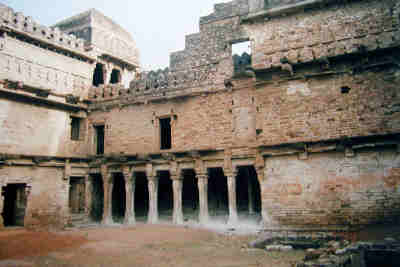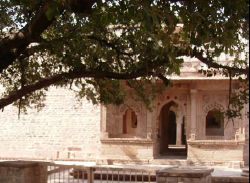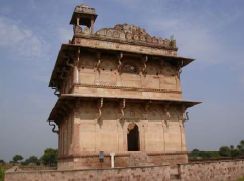
................................................................................................................................................................................................................................................................................................................................................................................................................................................................................................................

Copyright © visitindia.org.in. All Rights Reserved.
The Chanderi area has been a major center of Jain culture. It is situated at a distance of 127 km from Shivpuri, 37 km from Lalitpur, 55 km from Ashok Nagar and about 45 km from Isagarh. It is surrounded by hills southwest of the Betwa River. Chanderi is surrounded by hills, lakes and forests and is spotted with several monuments of the Bundela Rajputs and Malwa sultans.
Travelogues/Travel Logs of Roadtrips
Hit the road with the summary guides of our trips to various places in India. Any information feel free to drop a mail at info@visitindia.org.in


Get online driving directions, route guides, weekend planners, and customised itineries. Check out a few of our favorite user road trips, then start an adventure of your own.....Explore India by Road

Find us :-
Chanderi
Archeological Importance
The surrounding regions of Chanderi, Nannon, Budhi Chanderi, was also rich with its architectural and cultural heritage and had tremendous implications on the heritage and tourism of Chanderi. There is a cave near Nannon, 28 km south-west of Chanderi on the banks of river Urvashi, where rock painting is identified. A jaw and teeth of a mammoth which was of a hippopotamus 30000
year old was discovered here.
Another ancient site identified recently is the Baheti Math, where the structure of a temple dates back to the 5th century Gupta period (Picture 1-1). This lies about 20km south-east of Chanderi. Near the Baheti Math, a rock painting shelter site – Gitkhal Caves - was also identified


Chanderi Fort / Kirti Durg
The fort dates back to the 11th century and was built by Pratihara king Kirtipal. It is situated at a height of 230 feet on Chander giri hills. Johar smarak which was built as attribute to the rajput women who gave up their lives as satis during a war in 1528 and Khooni Darwaza are the important remnants of the fort. Khooni darwaza, a 15 m wide gate is hollow on either side of its 3.5m corbelled central opening. The corbelling is typical of Chanderi and used in combination with Ogee arches.
Battisi Baodi
The Baodi was built in 1485 A.D under the rule of Malwa sultan GyasShah Khilji. It has 32 ghats and same level of water in all the ghats lends its unique character.
Katighati
Katighati refers to a gate which was carved out of a massive rock of height 30 feet, length 192 feet and breadth 39 feet. Such a massive gate being carved out of a chisel and hammer lends the gate its unique identity.
Koshak Mahal
Historians believe that the Koshak Mahal was ordered to be built by Mahmud Khilji of Malwa when he passed through Chanderi in 1445 AD. The original plan of the Khilji ruler was to build a seven-storey palace though only two could be completed during his life time. The Mahal is divided into four equal parts and has architecture resembling that of Mandu
Jama Masjid
Jama Masjid is one of the oldest structures of Bundelkhand built to service the large Muslim population of Chanderi. It is located just outside Ander Shehar. Constructed in a unique style, stone slabs are interlocked to hold the brick outside finished with Lapis Lazuli glazed terracotta tiles. The intricate, ornamental and graceful serpentine brackets supporting the bold chhajja above the elegant ogee arches are distinct about Jama Masjid. They form the most exclusive feature of the early architecture of Chanderi


Badal Mahal Gateway
Exclusive to Chanderi, the Badal Mahal gateway is double arched with circular and tapering slender bastions on the two sides rising to a height of about 50 feet with a width of 25 feet. The opening between the tapering slender bastions is spanned by two ogee arches, one over the other with an intervening section filled in with filigree style jail and carving together forming a composition of
unparalleled beauty. This gate was probably constructed during the reign of Sultan Mamood Shah Khalji in 1450 and faces the Jama Masjid. They may have been gates to Mahals of Governors


Mazar Khandan-e- Hazrat Nizamuddin
The graveyard is believed to be built in the 15th century. There are several graves of saints within the enclosure constructed in exquisitely carved dark sandstone. The jaali work along with the symbolic motifs on the gravestone is believed to be exceptional. “Chanderi” appears for the first time in the inscriptions.
Bada Madarsa
This is a graveyard built in the 15th century. The jaali work and the carvings are exceptional beauty.
Shahzadi ka Roza
Shahzadi ka roza is situated outside the town in an abandoned and desolate place. It is a square building originally covered by a single dome that has now fallen. Masiive chhajjas rest on massive serpentine graceful brackets at two levels. Carved freize bears traces of glazed tiling. Parapet has beautifully designed merlons.

The dome in the centre was flanked on either corner by a square chhatri. The dome has now fallen down as also the three chhatries. The characteristic features of this tomb are the serpentine brackets used on the exterior in double series on all sides, ogee of the ornamental arches, large scale use of pendentives and stone work in the interior, chhatries on the superstructure and glazed tiling on the frieze. It appears to be built later than the Jama Masjid around 1470 A.D.
